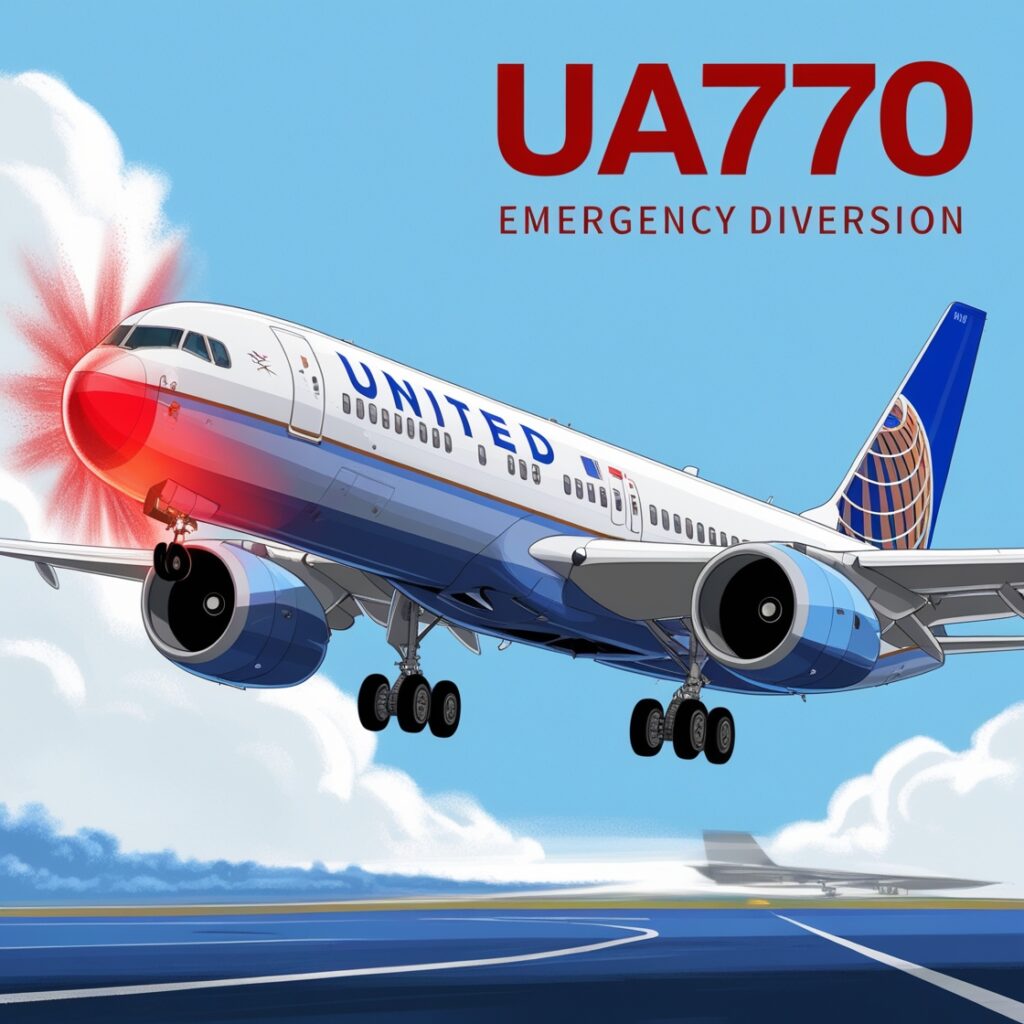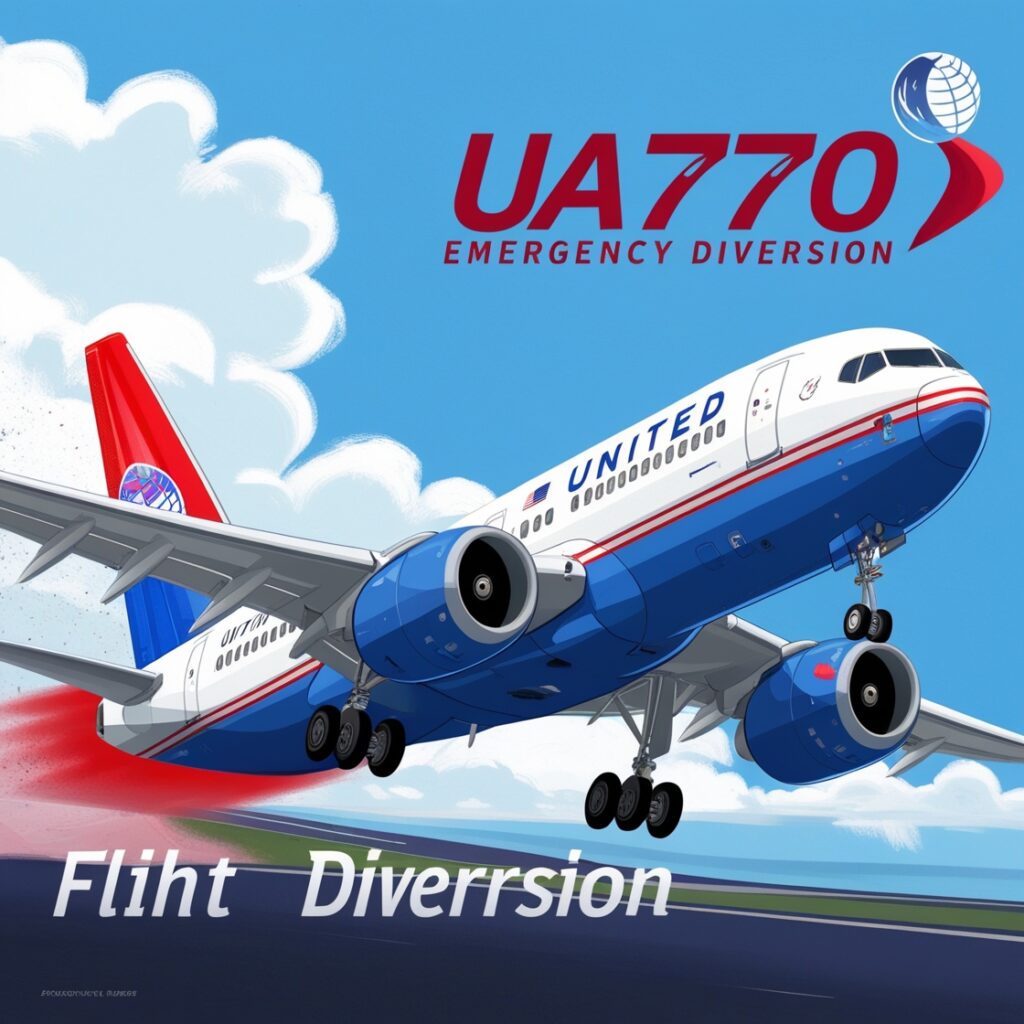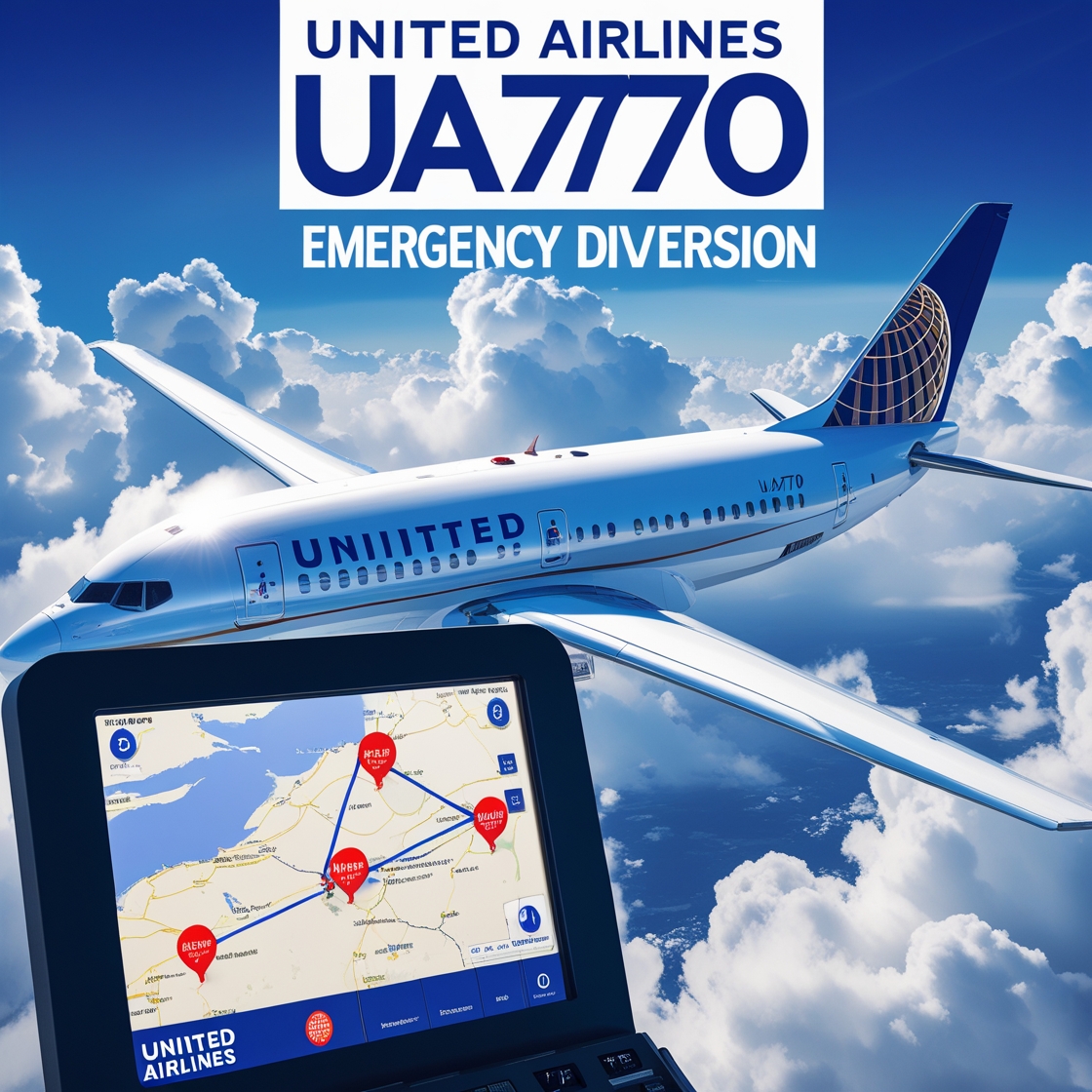What was once expected to be a routine trip swiftly turned into a tense and uncertain situation on United Airlines trip UA770.As the aircraft cruised thru its scheduled course, an unexpected emergency emerged—one not because of weather, but something a long way extra unsettling that demanded immediately motion from the flight team.
In a count of moments, a non violent journey transformed into a scenario that tested the readiness and coordination of absolutely everyone on board. The flight grow to be compelled to make a surprising diversion, catching the attention of aviation analysts and prompting rapid protection protocols.
This occasion not only underscores the inherent unpredictability of current air tour but additionally emphasizes the importance of rigorous schooling, real-time choice-making, and communique amongst airline employees and passengers. It’s a stark reminder that even as flying is statistically safe, moments like the ones beef up why protection remains the aviation enterprise’s highest priority.
In this complete evaluation, we’ll walk you through the timeline of what took place aboard Flight UA770, find out the probable causes at the back of the emergency, and acquire insights from aviation professionals and passengers who professional it firsthand. Fasten your seatbelt—what follows is a powerful inspect a 2nd in which every second counted.
The Reasons for United Airlines Flight UA770’s Diversion to London Heathrow: Planning, Security, and Reaction
When United Airlines Flight UA770 encountered an in-flight trouble over the Atlantic Ocean, the team hastily finished a diversion plan. Their preference to transport for London Heathrow Airport (LHR) wasn’t certainly ordinary—it emerge as a calculated flow into grounded in safety, performance, and infrastructure readiness.
Here’s a breakdown of the strategic factors within the lower back of that vital desire, how the incident spread out, and what it teaches us about aviation protection in recent times.
Why Heathrow Was the Chosen Diversion Point
The choice to divert to Heathrow wasn’t random. It was the end result of multiple actual-time issues via the flight group and operational support groups:

Geographic Advantage: As one of the closest primary airports in the course of the flight’s transatlantic course, Heathrow supplied the fastest access to secure touchdown processes for a wide-body plane just like the Boeing 787 Dreamliner.
Superior Infrastructure: Heathrow is equipped with robust emergency reaction competencies—together with advanced fire and rescue units, round-the-clock scientific services, and contemporary plane renovation facilities.
Passenger Logistics: As one of the busiest and most related airports in the international, Heathrow furnished seamless managing of passengers, from customs clearance to lodges, onward journey, and rebooking help.
At exactly 16:fifty five BST, Flight UA770 landed thoroughly on Runway 27R, and changed into directed to Gate B44, in which it was met with the aid of ground crews prepared for fast inspection and passenger assistance.
Inside the Cabin: How Passengers and Crew Handled the Situation
The professionalism of the cabin staff was demonstrated by the passengers’ descriptions of the flight’s atmosphere, which was extremely calm and organized despite the unexpected diversion.
Clear Communication: Flight attendants made everyday bulletins, ensuring travelers stayed knowledgeable and reassured throughout the descent and touchdown.
No Panic or Mask Deployment: Reports verify that oxygen mask were no longer deployed, indicating that whilst a pressurization problem changed into detected, cabin pressure remained inside a secure threshold.
Ground Support: Upon arrival, United Airlines staff furnished affected passengers with meal vouchers, lodge accommodations, and help with change tour preparations.
One passenger defined the experience as follows:
“There was a actual experience of harmony. The crew remained composed and reassuring the complete time. Their professionalism clearly made all of the difference.”
Post-Landing Protocol: Aircraft Inspection and Grounding
After touchdown, the plane underwent a series of opinions to determine the nature and volume of the difficulty. Early checks furnished a few key insights:
Pressurization Diagnostics: The major awareness of inspection changed into the cabin pressurization gadget, which plays a essential role in retaining a livable surroundings at cruising altitude.
No Structural Compromise: Preliminary assessments found out no visible damage to the aircraft’s airframe or fuselage.
Precautionary Grounding: The Dreamliner turned into officially grounded pending similarly exam and troubleshooting by way of United Airlines’ Maintenance Control Center (MCC). This step displays strict adherence to industry protection protocols.
Understanding Cabin Pressurization: Why It’s So Critical
At cruising altitudes, wherein business aircraft commonly perform between 30,000 and forty,000 feet, cabin pressurization is not only a comfort feature—it’s critical for survival.

Without it, passengers and crew are liable to:
Hypoxia: A circumstance attributable to low oxygen levels, which could impair cognitive feature and cause unconsciousness.
Physical Discomfort: Rapid adjustments in strain can purpose ear ache, sinus troubles, and dizziness.
In-Flight Risk: Even minor issues with pressurization systems need to be taken seriously to keep away from escalation.
This is why pilots and airways are trained to deal with any caution associated with pressurization as a functionality emergency, starting up immediately diversion protocols to make certain the safety of anyone on board.
See Also : Why Casîo Still Leads
United Airlines Flight UA770: How the Airline Managed the Post-Diversion Response
After the steady and controlled landing of United Airlines Flight UA770, the airline moved quick to address the incident and talk with the general public. In an legitimate declaration, United showed that the aircraft end up diverted as a safety precaution and reassured travelers that no passengers had been harmed at a few stage in the event. Their message contemplated a smooth precedence: maintaining the first-rate requirements of protection and transparency.
United additionally announced that the aircraft may want to live grounded until a complete technical inspection became completed thru licensed renovation personnel. This is a modern-day device designed to discover and resolve any underlying issues earlier than the aircraft re-enters service, ensuring passenger self guarantee and operational integrity.
Understanding Emergency Diversions: A Safety-First Strategy
Though incidents just like the UA770 diversion may additionally sound alarming to the general public, such choices are an vital a part of aviation safety protocols. Airlines are educated to behave hastily at the first signal of a potential issue—whether mechanical, scientific, or environmental.

An emergency diversion doesn’t necessarily indicate a catastrophic failure. In reality, maximum diversions are precautionary. Airlines, together with air site visitors controllers, work in tandem to reroute flights to the closest suitable airport to reduce ability dangers. Some common reasons for in-flight diversions include:
- Technical issues with the plane
- Severe climate in advance
- Medical emergencies regarding passengers or group
- Unruly behavior or protection-related incidents onboard
Airline crews undergo tremendous training to address every of those situations, with virtually described checklists, verbal exchange protocols, and coordination processes in location.
The Role of the FAA and Airline Maintenance After an In-Flight Incident
Following any declared in-flight emergency, the Federal Aviation Administration (FAA) steps in to evaluate the state of affairs.In the case of Flight UA770, the FAA showed it would evaluation the occasion as part of its standard publish-incident protocol. These investigations aren’t unusual and assist ensure that each one safety requirements are met or stepped forward upon.
Preliminary inner reviews endorse that the aircraft’s hydraulic or pressurization structures may be areas of challenge. As a result, United Airlines’ engineering team, along certified inspectors, is carrying out a complete diagnostic evaluation. Every component—specifically the ones involved inside the plane’s pressurization and environmental systems—is being tested to prevent recurrence.
This twin-layered technique from both airline and regulatory authorities reflects the industry’s commitment to transparency, duty, and passenger safety.
MCQs:
1. What prompted the emergency diversion of United Airlines Flight UA770?
A. Severe weather turbulence
B. A pressurization issue
C. A medical emergency
D. Fuel shortage
✔️ Correct Answer: B. A pressurization issue
2. Why was London Heathrow Airport selected as the diversion point?
A. It was the destination airport
B. It had the best inflight entertainment system
C. It offered proximity, infrastructure, and passenger logistics
D. It was suggested by passengers
✔️ Correct Answer: C. It offered proximity, infrastructure, and passenger logistics
3. At what time did Flight UA770 land at Heathrow?
A. 14:25 BST
B. 15:00 BST
C. 16:55 BST
D. 18:30 BST
✔️ Correct Answer: C. 16:55 BST
4. What did passengers say about the cabin crew during the incident?
A. They were confused and disorganized
B. They remained calm and professional
C. They did not provide any updates
D. They instructed passengers to disembark mid-air
✔️ Correct Answer: B. They remained calm and professional
5. What safety system was the primary focus of the post-landing inspection?
A. Electrical systems
B. Hydraulic landing gear
C. Fuel tanks
D. Cabin pressurization
✔️ Correct Answer: D. Cabin pressurization
6. What action was taken by United Airlines after landing?
A. The aircraft was immediately cleared to fly again
B. The plane was destroyed
C. The aircraft was grounded for a thorough inspection
D. Passengers were sent home without assistance
✔️ Correct Answer: C. The aircraft was grounded for a thorough inspection
7. What is hypoxia in the context of aviation?
A. Excessive fuel pressure
B. Low oxygen levels that can cause unconsciousness
C. A fire-related emergency
D. An engine overheating condition
✔️ Correct Answer: B. Low oxygen levels that can cause unconsciousness
8. Which organization is responsible for investigating in-flight emergencies in the U.S.?
A. NASA
B. TSA
C. FAA
D. CDC
✔️ Correct Answer: C. FAA
9. Which of the following was not listed as a common reason for emergency diversions?
A. Disruptive passengers
B. Severe weather
C. In-flight entertainment failure
D. Medical emergencies
✔️ Correct Answer: C. In-flight entertainment failure
10. What does the response to Flight UA770 highlight about modern aviation?
A. Entertainment quality is prioritized
B. Diversions are mostly public-relations events
C. Safety, transparency, and real-time decisions are critical
D. Pilots are discouraged from diverting
✔️ Correct Answer: C. Safety, transparency, and real-time decisions are critical
Summary:
United Airlines Flight UA770, a routine transatlantic adventure, professional an surprising in-flight pressurization problem that triggered an emergency diversion to London Heathrow Airport. The flight team acted swiftly and strategically, prioritizing protection and deciding on Heathrow for its proximity, infrastructure, and capability to cope with massive-frame plane and passenger logistics.
Despite the worrying state of affairs, the surroundings on board remained calm, way to the professionalism of the cabin organization and easy conversation. No oxygen masks had been deployed, indicating the trouble grow to be contained. Upon landing at 16:fifty five BST, passengers obtained useful resource from United frame of human beings, at the side of inns and rebooking help.
Read More About Travels At Cento magzine

